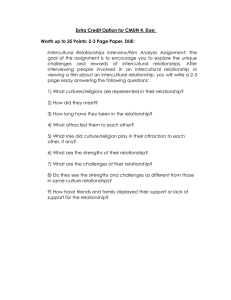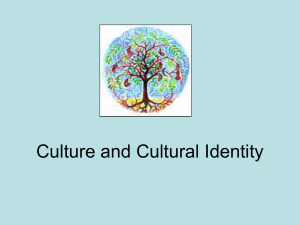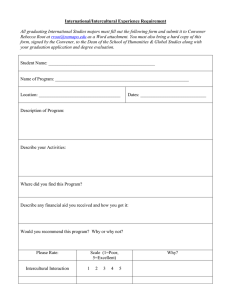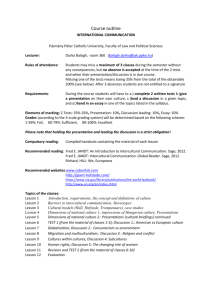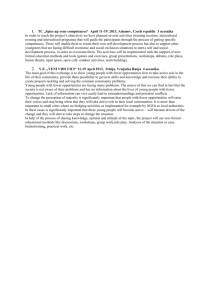Maui Community College Course Outline 1. Alpha and Number
advertisement
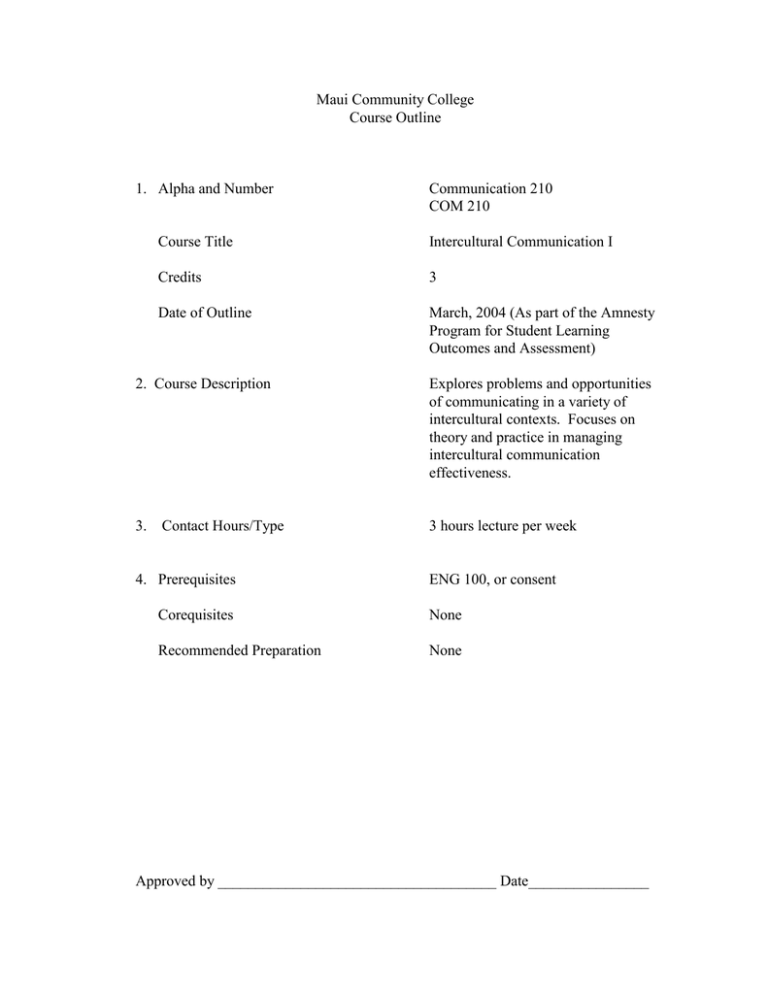
Maui Community College Course Outline 1. Alpha and Number Communication 210 COM 210 Course Title Intercultural Communication I Credits 3 Date of Outline March, 2004 (As part of the Amnesty Program for Student Learning Outcomes and Assessment) 2. Course Description Explores problems and opportunities of communicating in a variety of intercultural contexts. Focuses on theory and practice in managing intercultural communication effectiveness. 3. 3 hours lecture per week Contact Hours/Type 4. Prerequisites ENG 100, or consent Corequisites None Recommended Preparation None Approved by _____________________________________ Date________________ 2 5. General Course Objectives Communication 210 is a three-credit lower division course which is designed to provide an overview of the intercultural communication process. The United States is pluralistic nation composed of people with great differences in ethnic backgrounds, religions, socioeconomic levels, and native languages, in addition to natural diversities based on sex, age, and physical and mental abilities. These differences are particularly apparent in Hawaii. How students deal with these differences influences their potential for academic, social, and vocational success. This course may help students to contribute to and benefit from the nation's democratic society, overcoming effects of debilitating racism, classism, and sexism. For detailed information on how Communication 210 focuses on the Maui Community College general education standards, see the attached curricular grid. The main focus is on Standard 4, Oral Communication in an intercultural context. This requires critical thinking. Writing is used to develop both the oral and the critical thinking processes. Communication 210 fulfills three of the six credits in the English/ Communications requirement or three of the nine-twelve credits for the Humanities requirement for A.A. and A.S. degrees. Articulation is being applied for at other CCs. 6. Student Learning Outcomes For assessment purposes, these are linked to #7. Recommended Course Content. On successful completion of this course, students will be able to: a. demonstrate understanding of the elements of intercultural communication; b. describe the complexity of the intercultural communication process; c. apply effective communication skills in intercultural communication interactions to communicate more confidently; d. recognize and manage possible problems in intercultural communication; e. work individually and in small groups to present information to others; f. recognize and respond appropriately to nonverbal messages cross-culturally; g. handle intimidating intercultural situations; and h. recognize gender and cultural differences in intercultural communication; 7. Recommended Course Content and Approximate Time Spent on Each Topic Linked to #6. Student Learning Outcomes. 1 - 2 Weeks 1 - 2 Weeks 1 - 2 Weeks 1 - 3 Weeks Intercultural Communication Process (a, b, e) Relationship Between Communication and Culture (a, b, e) Perception and Communication (a, b, c, d, e) Personal Orientation System (a, b, c, d, e, h) 3 1 - 3 Weeks 1 - 3 Weeks 1 - 3 Weeks 1 - 3 Weeks 1 - 2 Weeks Social Institutions (a, b, c, d, e, g, h) Social Relationships (a, b, c, d, e, g, h) Verbal and Nonverbal Communication (a, b, c, d, e, f, g, h) Communicating Effectively Interculturally (a, b, c, d, e, f, g, h) Culture Shock (a, b, c, d, e, f, g, h) 8. Text and Materials, Reference Materials, Auxiliary Materials and Content An appropriate text(s) and materials will be chosen at the time the course is offered from those currently available in the field. Examples include: Gudykunst, W. B. (2003). Cross-cultural and intercultural communication. Sage. Hall, B. (2005). Among cultures: The challenge of communication, (2nd Ed.). Belmont, CA: Wadsworth, a division of Thomson Learning, Inc. Jandt, F. E. (2003). An introduction to intercultural communication: Identities in a global community, (4th Ed.). Sage. Klopf, D. W. (2001). Intercultural encounters, fifth edition: The fundamentals of intercultural communication, (5th Ed.). Morton Publishing Co. Martin, J. N., & Nakayama, T. K. (2005). Experiencing intercultural communication: An introduction, (2nd Ed.). McGraw Hill. Samovar, L.A., & Porter, R.E. (2004). Communication between cultures, (5th Ed.). Belmont, CA: Wadsworth, a division of Thomson Learning, Inc. 9. Recommended Course Requirements and Evaluation Specific course requirements are at the discretion of the instructor at the time the course is being offered. Suggested requirements might include, but are not limited to: Oral Exercises Written Exercises Journals Papers/Research Tests and Quizzes Class Activities Attendance Class Participation 10. Methods of Instruction 10 - 30 % 0 - 30 % 10 - 30 % 10 - 30 % 40 - 60 % 10 - 30 % 0 - 10 % 0 - 10 % 4 Methods of instruction will vary considerably with instructors. Specific methods will be at the discretion of the instructor teaching the course and might include, but are not limited to: a. b. c. d. e. f. g. h. i. j. k. lectures; large and small group discussions/activities; experiential exercises and problem solving; case studies; films, dvd, video tapes, television programs and other forms of media; group and individual projects and papers; assignments, tests, and reading; guest lecturers; role playing; service-learning, community service, and/or civic engagement projects; and other contemporary learning techniques (such as problem-based learning, investigative case-based learning, self-paced programs, etc.).
